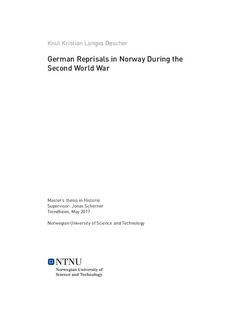| dc.description.abstract | The research topic of this master's thesis seeks to map the German use of reprisals as a tool of occupation in occupied Norway, between 1940 and 1945. As part of this effort, previous researches that have touched upon the subject are used as the base of the empirical content. The monographs are in part compared to each other, and in part compared to findings of this thesis. Later years has seen some of the perceptions of the war in Norway change. This includes the topic of reprisals. This thesis attempts to answer some questions regarding reprisals. What the German authorities did. Who among the German authorities made the decisions. What factors influenced the use of reprisals. Finally, how were the reprisals in Norway, compared to another occupied country, the Netherlands. In terms of methodology, the findings of this thesis are that executions and hostage-takings were the most common reprisal methods, followed by a handful of other methods, including civilian martial law. The methods mirrored the intentions of the most prominent German authority figure in Norway, Reichskommissar Josef Terboven. He considered Norway to be a side-step on the career ladder, and sought to stabilise the country, so he could leave for a more prestigious post. His main personal policies for achieving stability was to subdue the population, and to do as little damage as possible to the economy, while doing so. As a result of Terboven's ambitions and need for control, he sought to dominate the administration in Norway. As a result, he was the only one to order reprisals in Norway. In spite of his short temper, his ambitions seem to have moderated his decisions regarding reprisals. His temper also had the effect of turning the Berlin central leadership against him, limiting his reprisal options towards the end. The most important influences on the reprisals were the actions and policies of the Norwegian resistance movement, the distance to the front lines, and intervention from Berlin. The Netherlands has many things in common with Norway, making comparisons natural. However, the two countries are also different in some key ways, causing a greater toll on the Netherlands than on Norway, in terms of reprisals.
Occupied Norway suffered from the reprisals enacted upon the population during the war. Every reprisal is a tragedy in its own right. Compared to the Netherlands however, this thesis has found that the reprisals could have been a lot worse, if not for a few key differences, as described above. | nb_NO |
| dc.subject | Terboven, Josef, Seyss-Inquart, Arthur, Norway, World War Two, Second World War, Reprisals, resistance, resistance movement, occupation, Germany, Netherlands | nb_NO |
